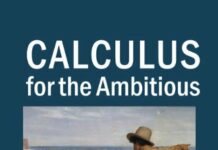
Ebook Info
- Published: 1996
- Number of pages: 784 pages
- Format: PDF
- File Size: 60.04 MB
- Authors: T. W. Körner
Description
What is the connection between the outbreak of cholera in Victorian Soho, the Battle of the Atlantic, African Eve and the design of anchors? One answer is that they are all examples chosen by Dr Tom Körner to show how a little mathematics can shed light on the world around us, and deepen our understanding of it. Dr Körner, an experienced author, describes a variety of topics which continue to interest professional mathematicians, like him. He does this using relatively simple terms and ideas, yet confronting difficulties (which are often the starting point for new discoveries) and avoiding condescension. If you have ever wondered what it is that mathematicians do, and how they go about it, then read on. If you are a mathematician wanting to explain to others how you spend your working days (and nights), then seek inspiration here.
User’s Reviews
Reviews from Amazon users which were colected at the time this book was published on the website:
⭐The Pleasures of Counting was not at all a dry read. Coming from a person who has struggled in math class not understanding how individual formulas could be applied to the outside world and not even understanding or remembering all of the rules of math, I went searching for a book that basically explained the `meaning of math in real life’ and this one definitely answered all my questions.Now there are two types of readers for this book. One type could just glance over the formulas applied to these real life scenarios, and just acquire a general sense of what the formulas accomplish (that’s me). But there are also analytical questions and problems that can be worked through with a calculator for the math readers who love math. So for me this book was more enrichment. But, if you are a college student majoring in math or a life learner of math this would definitely be a nice summer read for you. This book has such a wide range of topics that are expressed through math, almost like a history book through formulas. For example, the book showed how variables could represent a real life problem and how logically and realistically time could be shortened or wars could be one or a certain type of strategy could be applied because it was just proven by a definitive math problem. And that was pretty neat to see. T.W. Korner made the chapters flow effortlessly and kept my attention and it was easy to follow as it just went chronologically through history. And it is really fitting for Korner to write this because he’s a math professor and spends time working with math every day and his enthusiasm for math really could be seen. All in all, this book really seemed to tell the full intent and purpose of math. That math is more useful than just a type of counting system; that it can be more in depth than that and hold a higher cause.—-Breanna W
⭐At first this book may seem like a long, uninteresting read, but you will be amazed by the amount of things you will learn by the end of this book. Not only does it teach you different aspects of math, it also gives lessons about physics, astronomy, algorithms, biology, and a plentiful amount of useful theories. You will learn about theories that involve the everyday lives of regular people. That is another reason why “The Pleasures of Counting” is such a great read for anyone, not just mathematicians. This book tells you what mathematicians do and why they spend their time analyzing and creating these intriguing theories involving math and science. Korner brings his witty personality into writing each section of this book. He not only teaches you an abundant amount of valuable lessons, he does this in an engaging and captivating way. The style of writing has made this book an enthralling and relatively easy read. Although this novel mainly involves different topics of math, you will find a lot of the text to be about solving real world problems. By reading, T.W. Korner’s “The Pleasures of Counting” you will have much more insight on a variety of different topics that you never knew before.
⭐The author presents in-depth, unfamiliar encounters between mathematics and the real world. Two examples are the discovery of the causes of cholera and the battle against U-boats. Although I believe the book is intended to be largely intelligible to the ambitious high-school student, there is much here for the more advanced reader.
⭐Rambling series of sometimes interesting anecdotes. Nothing really ties it together. Not very instructive treatment of the math that does appear. Not really worth taking up space on the shelf.
⭐Arrived in good order and condition. D.L.
⭐Panoramic and beautiful. Many hours of pleasing math with wonderful background presentation.
⭐very good~O(∩_∩)O
⭐No question, this is a five star book, it is a nice tutorial overview of applied maths, the high point being a presentation of Turing’s analysis of the Enigma cypher at Bletchley, which I had never read before.I was surprised at some of the things cited (the first chapter on operational research in the first world war is not, shall we say, deep) and some of those that do not get cited, but de gustibus non disputandem est. And I would have to say that in general the contents were surprising in the best way, by being offbeat, and that is good.Nevertheless, I have a list of quibbles; here are some:First Körner makes some foolishly dismissive – to be kind – remarks about economics, which reveal only that he does not seem to know a lot about the subject.Second, he also makes some foolish jokes about masters and servants; he glosses his description of Halmos’s Naive set theory as a gentleman’s guide by explaining that a gentleman should know how to drive, but probably prefers to let his chauffeur do it most of the time. He makes similar remarks about valets and algorithms (an algorithm is something that your valet could perform). One gets the feeling he would have felt more comfortable on the prosecution side at the Chatterley trial.When I was doing my PhD, I remember one of the other students attempted to cultivate a gentleman’s attitude to the computer on which he did his research. This was not as endearing a pose as he thought.Third, maybe a little less aristocratic disdain about foundations would have improved the final dialogue about the axiomatic method, where complex technical issues are simply brushed under the rug without mention. Yes, the standard axioms for addition and multiplication, plus induction, do define the natural numbers up to isomorphism, but not in a standard first-order language. Surely such a point is germane to the discussion (or reason to have another discussion instead, if you do not want to confuse a beginner with end extensions and non-standard models).But a nice book, and I look forward to reading bits of it more carefully sometime soon.
⭐I can’t praise this book highly enough. I just wish I had more time to “mine” its depths.The subject matter is maths, of course. But the approach puts the maths into the context of how it is used to solve real-world problems – giving an insight into the development of applied mathematics – often mistaken as mechanics and stats.Korner’s description of the people behind the maths, particularly Richardson, is very warm and helps you feel how particular problems were tackled.The style is “literary” and the exercises, which are scattered throughout, “emerge” from the text. This provides real motivation for the problems – and motivates the reader to learn something by attempting them. It reminded me of Polya’s classic “How to Solve It” (now that’s an ABSOLUTE must).I think Korner’s target of a bright teenager is a bit ambitious. I feel the intended reader would have to be a pretty serious minded individual destined for the “premier division” maths departments to get much out of the book – but I may be underestimating the potential of the readers.
⭐A great book for anyone interested in maths, particularly anyone working on an ‘A’ level who could use some motivation. The book takes serious examples of how maths has been used on a wide range of problems, and invites the reader to have a go.
⭐Very well written by an expert. Ranks alongside the work of Martin Gardner with ideas explored to some depth. Choice of topics is arbitrary but all of interest. Does not require advanced mathematics knowledge.
⭐This is a book that rewards repeated reading over years.
⭐No question, this is a five star book, it is a nice tutorial overview of applied maths, the high point being a presentation of Turing’s analysis of the Enigma cypher at Bletchley, which I had never read before.I was surprised at some of the things cited (the first chapter on operational research in the first world war is not, shall we say, deep) and some of those that do not get cited, but de gustibus non disputandem est. And I would have to say that in general the contents were surprising in the best way, by being ofbeat, and that is good.Nevertheless, I have a list of quibbles; here are some:First, he makes some foolishly dismissive – to be kind – remarks about economics, which reveal only that he does not seem to know a lot about the subject.Second, he makes some foolish jokes about masters and servants; he glosses his description of Halmos’s Naive set theory as a gentlemans guide by explaining that a gentleman should know how to drive, but probably prefers to let his chauffeur do it most of the time. He makes similar remarks about valets and algorithms (an algorithm is something that your valet could perform). One gets the feeling he would have been on the prosecutions side over lady Chatterley’s Lover.When I was doing my PhD, I remember one of the other students attempted to cultivate a gentleman’s attitude to the computer on which he did his research. This was not as endearing a pose as he thought.Third, maybe less aristocratic disdain about foundations would have improved the final dialogue about the axiomatic method, where complex technical issues are simply brushed under the rug without mention. Yes, the standard axioms for addition and multiplication, plus induction, do define the natural numbers up to isomorphism, but not in a standard first-order language. Surely such a point is germane to the discussion (or reason to have another discussion instead, if you do not want to confuse a beginner with end extensions and non-standard models).But a nice book, and I look forward to reading bits of it more carefully sometime soon.
Keywords
Free Download The Pleasures of Counting 1st Edition in PDF format
The Pleasures of Counting 1st Edition PDF Free Download
Download The Pleasures of Counting 1st Edition 1996 PDF Free
The Pleasures of Counting 1st Edition 1996 PDF Free Download
Download The Pleasures of Counting 1st Edition PDF
Free Download Ebook The Pleasures of Counting 1st Edition



